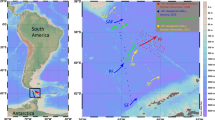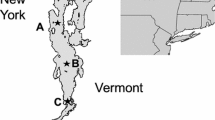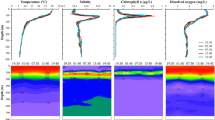Abstract
Analyses of day/night changes in the bathymetric distribution of micronektonic biomass at 16 stations in the northeastern Atlantic, sampled between 1978 and 1994, provided quantitative estimates of the organic carbon fluxes associated with diel vertical migration of individual taxa of micronekton. Gelatinous taxa contributed 50–80% of the integrated standing crop by volume but, apart from tunicates, contributed relatively little to the active migratory fluxes when expressed in terms of carbon. Total micronektonic migratory fluxes into the upper 200 m ranged from 12.5 to 58 mgC per m2. At 15 stations, fish and pteropods provided 50–80% of the fluxes into the upper 100, 200 and 400 m. At one station, tunicates (pyrosomes) contributed substantially. Wherever tunicates or the medusa Pelagia were swarming, migrations by other taxa appear to be suppressed. The mean proportions of the stock (in terms of biomass) of each of the dominant migratory taxa entering and leaving the upper 100 m were 23% for tunicates, 18% for fish, 22% for pteropods, 8% for decapod crustaceans and 23% for euphausiids. The maximum proportions for these five taxa were 90%, 60%, 75%, 25% and 75%, respectively. Similar estimates of the mean fluxes into and out of the upper 400 m were generally higher: 19% for tunicates, 39% for fish, 28% for pteropods, 49% for decapods and 55% for euphausiids; the respective maxima were 99%, 74%, 99%, 72% and 91%. It is estimated for fish that if these migrations occur throughout the year, they will result in an active carbon export (both POC and DOC) from the wind-mixed layer and immediate sub-thermocline depths of about 500% of the mean annual standing stock. If this estimate can be extended to other taxa, then the material fluxes resulting from these active migrations will be quantitatively similar to those resulting from the deposition of phytodetritus at temperate latitudes.
Similar content being viewed by others
References
Allison, S. K. & K. F. Wishner, 1986. Spatial and temporal patterns of zooplankton biomass across the Gulf Stream. Mar. Ecol. Prog. Ser. 31: 233–244.
Angel, M. V., 1985. Vertical migrations in the oceanic realm: possible causes and probable effects. In Rankin, M. A. (ed.), Migration, Mechanisms and Adaptive Significance. Contributions in Marine Science, Texas, 27: supplement: 45–70.
Angel, M. V., 1989a. Does mesopelagic biology affect the vertical flux? In Berger, W. H., V. S. Smetacek & G. Wefer (eds), Productivity of the Oceans: Past and Present. Proceedings of Dahlem Workshop on...). John Wiley: 155–173.
Angel, M. V., 1989b. Vertical profiles of pelagic communities in the vicinity of the Azores Front and their implications to deep ocean ecology. Prog. Oceanogr. 22: 1–46.
Angel, M. V., 1990. Life in the benthic boundary layer: connections to the mid-water and sea floor. Phil. Trans. r. Soc., Lond. A 331: 15–28.
Angel, M. V. & P. M. Hargreaves, 1992. Large scale patterns in the distributions of planktonic and micronektonic biomass in the N.E.Atlantic. ICES J. mar. Sci. 49: 403–411.
Angel, M. V., P. Hargreaves, P. Kirkpatrick & P. Domanski, 1982. Low variability in planktonic and micronektonic populations at 1000 m depth in the vicinity of 42° N 17° W; Evidence against diel vertical migratory behaviour in the majority of species. Biol. Oceanogr. 1: 287–319.
Atkinson, A., P. Ward & E. J. Murphy, 1996. Diel periodicity of subantarctic copepods: relationships between vertical migration, gut fullness and gut evacuation rate. J. Plankton Res. 18: 1387–1406.
Baird, R. C., T. L. Hopkins & D. F. Wilson, 1975. Diet and feeding chronology of Diaphus taaningi (Myctophidae) in the Cariaco Trench. Copeia 1975 (2): 356–365.
Bishop, J. K. B., R.W. Collier, D. R. Ketten & J. M. Edmond, 1980. The chemistry, biology and vertical flux of particulate matter from the upper 1500 m of the Panama Basin. Deep-Sea Res. 27: 615–640.
Campbell, J. W. & T. Aarup, 1992. New production in the North Atlantic derived from seasonal patterns of surface chlorophyll. Deep-Sea Res. 39: 1669–1694.
Copping, A. E. & C. J. Lorenzen, 1980. Carbon budget of a marine phytoplankton-herbivore system with carbon-14 as a tracer. Limnol. Oceanogr. 25: 873–882.
Dagg, M. J., 1976. Complete carbon and nitrogen budgets for the carnivorous amphipod, Calliopius laeviusculus (Kröyer). Int. Rev. ges. Hydrobiol. 61: 297–357.
Dam, H. G., M. R. Roman & M. J. Youngbluth, 1995. Downward export of respiratory carbon and dissolved inorganic nitrogen by diel-migrant mesozooplankton at the JGOFS Bermuda time-series station. Deep-Sea Res. 42: 1187–1197.
Domanski, P. A., 1986. The Azores Front: A zoogeographical boundary? UNESCO Tech. Pap. Mar. Sci. 49: 73–83.
Frost, B. W., 1988. Variability and possible adaptive significance of diel migration in Calanus pacificus, a planktonic marine copepod. Bull. mar. Sci. 43: 675–694.
Gorelova, T. A. & S. G. Kobylyansky, 1985. Feeding of deep-sea fishes of the Family Bathylagidae. J. Ichthyol. 32: 264–274.
Gould, W. J., 1985. The physical oceanography of the Azores Front. Prog. Oceanogr. 14: 167–190.
Fasham, M. J. R., T. Platt, B. Irwin and K. Jones, 1985. Factors affecting the spatial pattern of the deep chlorophyll maximum in the region of the Azores Front. Progr. Oceanogr. 14: 129–165.
Foxton, P. & H. S. J. Roe, 1974. Observations on the nocturnal feeding of some mesopelagic decapod Crustacea. Mar. Biol. 28: 37–49.
Harbison, G. R, L. P. Madin & N. R. Swanberg, 1978. On the natural history and distribution of oceanic ctenophores. Deep-Sea Res. 25: 233–256.
Harding, G. C., W. P. Vass, B. T. Hargrave & S. Pearre Jr., 1986. Diel vertical movements and feeding activity of zooplankton in St George's Bay N.S., using net tows and a newly developed passive trap. Can. J. Fish. aquat. Sci. 43: 952–967.
Hargreaves, P. M., C. J. Ellis & M. V. Angel, 1984. An assessment of biological processes close to the sea bed in a slope region and its significance to the assessment of sea bed disposal of radioactive waste. IOS Report 185: 121 pp.
Hays, G. C., A. J. Warner & D. Lefevre, 1996. Long term changes in the diel vertical migration behaviour of zooplankton. Mar. Ecol. Prog. Ser. 141: 149–159.
Heron, A. C., 1972. Population ecology of a colonizing species: the pelagic tunicata Thalia democratica. 1. Individual growth rate and generation time. Oecologia 10: 269–293.
Hopkins, T. L., T. T. Sutton & T. M. Lancraft, 1996. The trophic structure and predation impact of a low latitude midwater fish assemblage. Prog. Oceanogr. 38: 95–153.
Hunt. H. G., 1968. Continuous plankton records: Contribution towards a plankton atlas of the North Atlantic and North Sea. Part XI: The seasonal and annual distributions of Tahliacea. Bull. mar. Ecol. 6: 225–249.
Ikeda, T. & H. R. Skjodal, 1989. Metabolism and elemental composition of zooplankton from the Barents Sea during early Arctic summer. Mar. Biol. 100: 173–183.
Irwin, B., T. Platt, P. Lindley, M. J. R. Fasham & K. Jones, 1983. Phytoplankton productivity in the vicinity of a front, SW of the Azores during May 1981. Can. Data Rep. Fish. aquat. Sci. 400: 1–100.
Iwasa, Y., 1982. Vertical migration of zooplankton: a game between predator and prey. Am. Nat. 20: 171–180.
Lampert, W., 1989. The adaptive significance of diel vertical migration of zooplankton. Funct. Ecol. 3, 21–27.
Lampitt, R. S., W. R. Hillier & P. G Challenor, 1993a. Seasonal and diel variation in the open ocean concentration of marine snow aggregates. Nature, London, 362: 737–739.
Lampitt, R. S., K. F. Wishner, C. M. Turley & M. V. Angel, 1993b. Marine snow studies in the Northeast Atlantic Ocean: distribution composition and role as a food source for migrating plankton. Mar. Biol. 116: 689–702.
Larson, R. J., 1986. Water content, organic content and carbon and nitrogen composition of medusae from the Northeast Pacific. J. exp mar. Biol. Ecol. 99: 107–120.
Lee, C., S. G. Wakeham & J. I. Hedges, 1988. The measurement of oceanic particle flux-are 'swimmers’ a problem? Oceanography, November: 34–36.
Longhurst, A. R., 1976. Vertical migration. In Cushing, D. H. & J. J. Walsh (eds), The Ecology of the Seas.W. B. Saunders: 116–137.
Longhurst, A. R., 1995. Seasonal cycles of pelagic production and consumption. Progr. Oceanogr. 36: 77–168.
Longhurst, A. R. & W. G. Harrison, 1988. Vertical nitrogen flux from the oceanic photic zone by diel migrant zooplankton and nekton. Deep-Sea Res. 35: 881–889.
Longhurst, A. R. & W. G. Harrison, 1989. The biological pump: Profiles of plankton production and consumption in the upper ocean. Prog. Oceanogr. 22: 47–123.
Longhurst, A. R., A. W. Bedo, W. G. Harrison, E. J. H. Head, E. P. Irwin & C. Morales, 1989. NFLUX: a test of vertical migration flux by diel migrant biota. Deep-Sea Res. 36: 1705–1719.
Longhurst, A. R., A. W. Bedo, W. G. Harrison, E. J. H. Head & D. D. Sameoto, 1990. Vertical flux of respiratory carbon by diel migrant biota. Deep-Sea Res. 37: 685–694.
Merrett, N. R. & H. S. J. Roe, 1974. Patterns and selectivity in the feeding of certain mesopelagic fishes. Mar. Biol. 28: 115–126.
Oceanographic Laboratory, Edinburgh, 1973. Continuous plankton records; a plankton atlas of the North Atlantic and the North Sea. Bull. mar. Ecol. 7: 1–174.
Pearre, S., 1979. Problems of detection and interpretation of vertical migration. J. Plankton Res. 1: 29–44.
Pfannkuche, O., 1993. Benthic response to the sedimentation of particulate organic matter at the BIOTRANS station, 47° N, 20° W. Deep-Sea Res. II 40: 135–149.
Pugh, P. R., 1989. Gelatinous zooplankton-the forgotten fauna. Prog. Underwater Sci. 14: 67–78.
Pugh, P. R., 1991. Co-occurrence of hippopodid siphonophores and their potential prey. Hydrobiologia 216/217: 327–334.
Pugh, P. R., F. Pages & B. Boorman, 1997. Vertical distribution and abundance of pelagic cnidarians in the eastern Weddell Sea, Antarctica. J. mar. biol. Ass. U.K. 77: 341–360.
Ringelberg, J., 1964. The positively phototactic reaction of Daphnia magna Straus: a contribution to the understanding of diurnal vertical migration. Neth. J. Sea Res. 2: 319–406.
Ringelberg, J., 1991. Enhancement of the phototactic reaction in Daphnia hyalina by a chemical mediated by juvenile perch (Perca fluviatilis). J. Plankton Res. 13: 17–25.
Roe, H. S. J. & J. Badcock, 1984. The diel migrations and distributions within a mesopelagic community in the northeast Atlantic. 5. Vertical migrations and feeding of fish. Progr. Oceanogr. 13: 389–424.
Roe, H. S. J. & D. M. Shale, 1979. A new multiple rectangular trawl (RMT 1+8M) and some modifications to the Institute of Oceanographic Sciences’ RMT 1+8. Mar. Biol. 50: 283–288.
Roe, H. S. J., A. De C. Baker, R. M. Carson, R. Wild & D. M. Shale, 1980. Behaviour of the Institute of Oceanographic Sciences’ Rectangular Midwater Trawls: theoretical aspects and experimental observations. Mar. Biol. 56: 247–259.
Roe, H. S. J., D. S. M. Billett & R. S. Lampitt, 1990. Benthic/midwater interactions on the Madeira Abyssal Plain; evidence for biological transport pathways. Progr. Oceanogr. 24: 127–140.
Roe, H. S. J., M. V. Angel, J. Badcock, P. Domanski, P. T. James, P. R. Pugh & M. T. Thurston, 1984. The diurnal migrations and distributions of a mesopelagic community in the North-east Atlantic. Progr. Oceanogr. 13: 245–511.
Roman, M. R., H. G. Dam, A. L. Gauzens & J. M. Napp, 1993. Zooplankton biomass and grazing at the JGOFS Sargasso Sea time series station. Deep-Sea Res. 1: 40: 883–901.
Savidge, G., D. R. Turner, P. H. Burkill, A. J. Watson, M. V. Angel, R. D. Pingree, H. Leech & K. J. Richards, 1992. The BOFS 1990 Spring Bloom Experiment: Temporal evolution and spatial variability of the hydrographic field. Prog. Oceanogr. 29: 235–281.
Small, L. F. & S. G. Ellis, 1992. Fecal carbon production by copepods in the Santa Monica Basin; the effects of body size and carnivorous feeding. Prog. Oceanogr. 30: 197–221.
Small, L. F., S. W. Fowler, S. A. Moore & J. Larosa, 1983. Dissolved and fecal pellet carbon and nitrogen release by zooplankton in tropical waters. Deep-Sea Res. 10: 1199–1220.
Steinberg, D. K., C. A. Carlson, N. R. Bates, S. A. Goldthwait, L. P. Madin & A. F. Michaels, 2000. Zooplankton vertical migration and the active transport of dissolved organic and inorganic carbon in the Sargasso Sea. Deep-Sea Res. I, 47: 137–158.
Vane, F. R. & J. M. Colebrook, 1962. Continuous Plankton Records: contribution towards a plankton atlas of the North-east Atlantic and the North Sea. Part vi: The seasonal and annual distributions of the Gastropoda. Bull. Mar. Ecol. 5: 247–253.
Vinogradov, M. E., 1968. Vertical Distribution of the Oceanic Zooplankton. Nauka, Moscow: 339 pp (translation: Israel Program for Scientific Translation, Jerusalem, 1970).
Vuorinen, I., 1987. Vertical migration of Eurytemora (Crustacea, Copepoda), a compromise between the risk of predation and decreased fecundity. J. Plankton Res. 9: 1037–1046.
Walsh, J., J. Dymond & R. Collier, 1988. Rates of recycling of biogenic components of settling particles in the ocean derived from sediment trap experiments. Deep-Sea Res. 35: 43–58.
Wiebe P. H., S. Boyd. & J. L. Cox, 1975. Relationships between zooplankton displacement volume, wet weight, dry weight and carbon. Fish. Bull. 73: 777–786
Wiebe, P. H., 1988. Functional regression equations for zooplankton displacement volumes, wet weight, dry weight, and carbon: a correction. Fish. Bull. 86: 833–835.
Wiebe, P. H., L. P. Madin, L. R. Haury, G. R. Harbison & L. M. Philbin, 1978. Diel vertical migration by Salpa aspera: potential for large-scale particulate organic matter transport to the deep-sea. Mar. Biol. 53: 249–256.
Wishner, K. F., 1980. The biomass of deep-sea benthopelagic plankton. Deep-Sea Res. 27: 203–216.
Zaret, T. M. & J. S. Suffern, 1976. Vertical migration in zooplankton as a predator avoidance mechanism. Limnol. Oceanogr. 21: 804–813.
Rights and permissions
About this article
Cite this article
Angel, M., Pugh, P. Quantification of diel vertical migration by micronektonic taxa in the northeast Atlantic. Hydrobiologia 440, 161–179 (2000). https://doi.org/10.1023/A:1004115010030
Issue Date:
DOI: https://doi.org/10.1023/A:1004115010030




